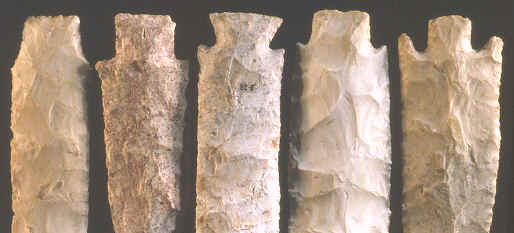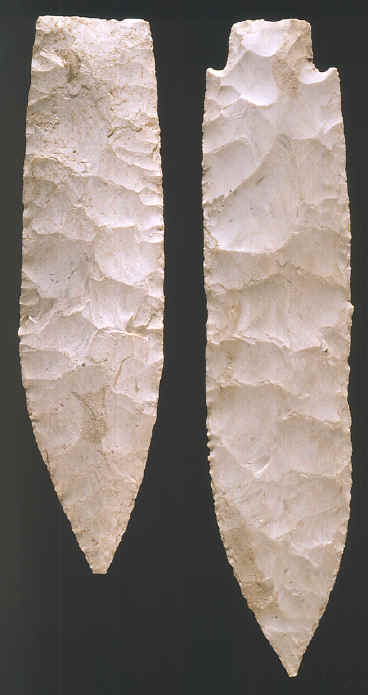|
|
|
Most Etley points are made of un-heat treated white Burlington chert. Only a small percentage have color. The quality of stone didn't seem to matter to the Etley knappers. Most of their points were made from rough textured chert. Very few were made from fine grained glossy chert. |
|
|
|
|
Most Etley points were not made with great care. They are not very symmetrical and in fact, a high percentage of them are rather crudely made. The majority of them have huge flake scars on both sides. They were made with percussion and pressure flaking. The preform reduction process was done with percussion and edge trimming and basal notching was done with pressure flaking. Today's skilled flintknappers can make an average sized 4 or 5 inch Etley point in 30 to 60 minutes. |
|
|
Etley points were apparently used as knives. But the needle-like points on some of them suggests they could also have been used as daggers. Some Etley points may even have been used on thrusting spears. Their large size allowed them to be resharpened several times. Greg Perino reports that they range in size from 3 to 11 inches long. Average lengths for Etley points, reported from different sites, range from 3 1/4 to 6 3/4. Burial sites have probably produced the largest and finest crafted examples. Habitation sites have produced the largest numbers of Etley points. |
|
|
|
|
Etley craftsmen produced many different types of artifacts. Some of the artifacts found on their sites are Wadlow points, Stone Square Stemmed points, bannerstones, copper awls & celts, grooved axes and plummets. |
|
|
Many hundreds of pounds of Etley points must have been surface collected and excavated from farmers fields over that last 150 years. They are so common that their numbers may even be measured in tons. Most of them are large and were made of lightly colored chert so it's easy to see them laying on cultivated ground. The Etley point represents just one of a vast number of different types of stone tools from this area of the county---------but its great size makes them stand out in the crowd. |
|
|
"REFERENCES"
1985,
Perino, Gregory, "Etley," Selected Preforms, points and
Knives of the North American Indians, p.127. |
|




